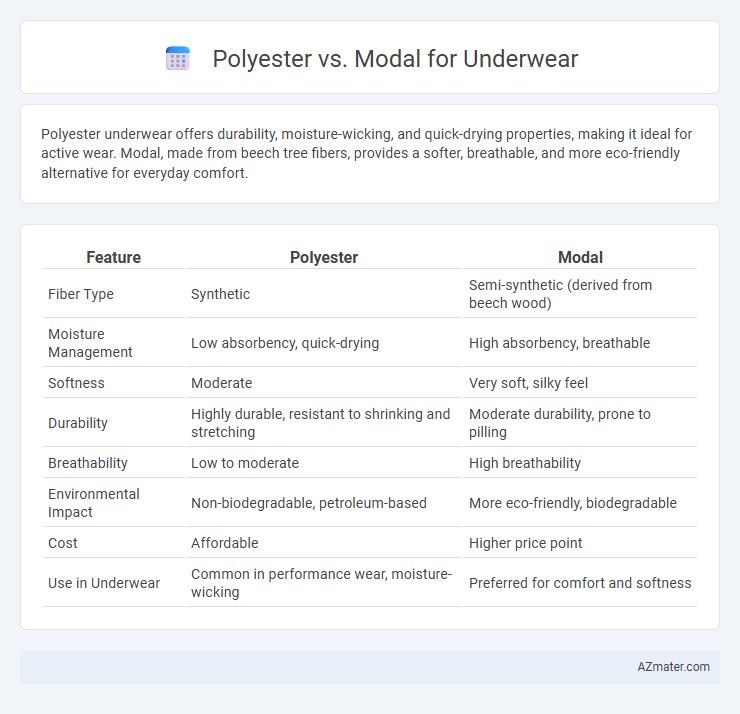Polyester underwear offers durability, moisture-wicking, and quick-drying properties, making it ideal for active wear. Modal, made from beech tree fibers, provides a softer, breathable, and more eco-friendly alternative for everyday comfort.
Table of Comparison
| Feature | Polyester | Modal |
|---|---|---|
| Fiber Type | Synthetic | Semi-synthetic (derived from beech wood) |
| Moisture Management | Low absorbency, quick-drying | High absorbency, breathable |
| Softness | Moderate | Very soft, silky feel |
| Durability | Highly durable, resistant to shrinking and stretching | Moderate durability, prone to pilling |
| Breathability | Low to moderate | High breathability |
| Environmental Impact | Non-biodegradable, petroleum-based | More eco-friendly, biodegradable |
| Cost | Affordable | Higher price point |
| Use in Underwear | Common in performance wear, moisture-wicking | Preferred for comfort and softness |
Introduction to Polyester and Modal Fabrics
Polyester is a synthetic fabric known for its durability, moisture-wicking properties, and resistance to shrinking and stretching, making it a popular choice in underwear for its long-lasting performance. Modal, derived from beech tree pulp, is a semi-synthetic fiber celebrated for its exceptional softness, breathability, and absorbency, offering superior comfort against the skin. Both fabrics provide unique advantages in underwear production, with polyester excelling in strength and moisture management, while modal prioritizes softness and natural feel.
Key Characteristics of Polyester Underwear
Polyester underwear is highly durable, moisture-wicking, and quick-drying, making it ideal for active lifestyles. Its synthetic fibers provide excellent stretch and shape retention while resisting wrinkles and shrinking. Polyester also offers good colorfastness, maintaining vibrant hues even after multiple washes.
Key Characteristics of Modal Underwear
Modal underwear offers exceptional softness and breathability due to its semi-synthetic fabric derived from beech tree pulp, making it highly comfortable for sensitive skin. It excels in moisture-wicking properties and maintains color vibrancy even after multiple washes, providing durability and long-lasting wear. The fabric's natural flexibility and resistance to shrinkage contribute to a perfect fit and shape retention, outperforming conventional polyester in comfort and sustainability.
Comfort and Softness Comparison
Modal fabric offers superior softness and breathability compared to polyester, making it highly comfortable for underwear, especially in warm climates. Polyester is durable and moisture-wicking but tends to feel less soft and can trap heat against the skin. For those prioritizing comfort and a smooth, gentle texture, modal is often the preferred choice over polyester in underwear fabrics.
Moisture-Wicking and Breathability
Polyester offers high moisture-wicking properties, swiftly drawing sweat away from the skin to keep underwear dry during intense activities. Modal excels in breathability, made from natural fibers that allow better air circulation, reducing heat buildup and enhancing comfort. Combining polyester's moisture management with modal's ventilation creates optimal underwear for staying cool and dry.
Durability and Longevity
Polyester underwear is highly durable due to its synthetic fibers, which resist stretching, shrinking, and abrasion, making it ideal for long-term use. Modal, derived from beech tree pulp, offers softness and breathability but tends to wear out faster over time as its fibers can weaken with repeated washing and friction. Choosing polyester ensures superior longevity and maintains shape better, while modal prioritizes comfort with moderate durability.
Care Instructions and Maintenance
Polyester underwear requires low-maintenance care, thriving in machine wash cycles with cold or warm water and quick drying on low heat without losing shape. Modal fabric demands gentle washing in cool water, preferably hand-washed or using a delicate cycle, with air drying recommended to maintain its softness and prevent shrinkage. Both fibers benefit from avoiding bleach and ironing at high temperatures to extend underwear longevity and preserve fabric integrity.
Environmental Impact and Sustainability
Modal fabric, derived from beech tree pulp, is biodegradable and produced using less water and energy compared to polyester, making it a more sustainable choice for underwear. Polyester, a synthetic material made from petrochemicals, has a significant environmental footprint due to its reliance on non-renewable resources and its non-biodegradable nature, contributing to microplastic pollution. Choosing modal underwear supports reduced environmental impact through renewable raw materials and a lower ecological footprint in production and disposal.
Price Differences and Value for Money
Polyester underwear often comes at a lower price point due to its synthetic nature and mass production, making it a budget-friendly choice. Modal fabric, derived from beech tree fibers, generally costs more but offers superior breathability, softness, and moisture-wicking properties, enhancing overall comfort and durability. When considering value for money, modal provides a longer-lasting and more comfortable wear experience, while polyester is ideal for those prioritizing affordability.
Which is Better for Underwear: Polyester or Modal?
Modal underwear offers superior breathability and moisture-wicking properties compared to polyester, making it more comfortable for all-day wear and sensitive skin. Polyester is more durable and resistant to shrinking or stretching, providing long-lasting support and shape retention during active use. Choosing between polyester and modal depends on whether comfort and softness (modal) or durability and resilient fit (polyester) are the primary priorities for the wearer.

Infographic: Polyester vs Modal for Underwear
 azmater.com
azmater.com